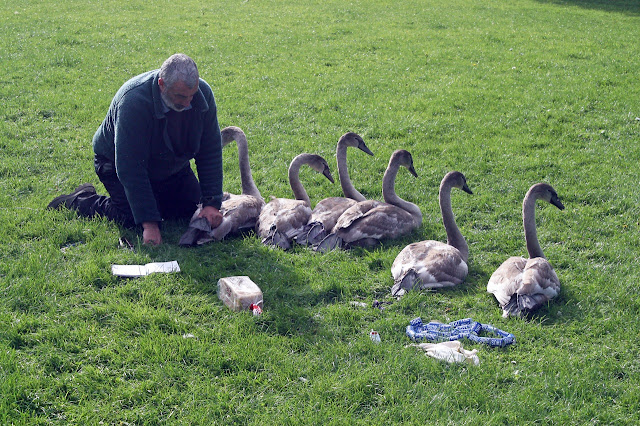On Monday, with Kelvin Jones, and on Wednesday, with Paul Ashworth and Martin Grant, I headed out to various regularly visited Mute Swan breeding sites in order to round-up and colour-ring this year’s crop of cygnets. Many people believe that all swans in Britain belong to the Queen and that this is why they are ringed. In reality, although all swans are legally protected under the Wildlife and Countryside Act, the Queen only officially owns those swans on the Thames between Sunbury and Abingdon Bridge that aren’t owned by either the Vintners or the Dyers, the last remaining companies with swan-upping rights on the Thames. Swans elsewhere in Britain may or may not be ringed as part of a nationally co-ordinated research programme run by the British Trust for Ornithology and the Wildfowl and Wetlands Trust. Much of this, as with us in Mid-Wales and Shropshire, is done by licensed amateurs who not only give of their own time and petrol but also pay for their own rings and equipment. To fit a Swan with a British Trust for Ornithology metal ring and a plastic “Darvic” costs just over £2.00. Currently we ring about 100 swans annually which represents a substantial investment.
Ringing not only allows detailed life histories to be collected on individual birds, it also allows for the subsequent monitoring of the large number of swans treated at Wildlife Hospitals and Rescue Centres. Getting records of swans living normal lives and breeding happily after intensive treatment for powerline injuries or oil pollution is not only incredibly rewarding for the rescuer but also shows that wildlife rescue is more than just about satisfying a human need to care for sick animals, it also shows that full rehabilitation back into the wild is possible, even after severe injury. Being able to recognise individuals also means that you can return them to where they belong and even reintroduce them to their long-term partners. As such I have been ringing rehabilitated swans at Cuan House Wildlife Rescue for many years and Megan Morris Jones has been helping with the cost of all our swan ringing for some time. Her support and assistance is very much appreciated.
Over the two days, 48 cygnets and 1 adult were ringed and it was nice to meet up with some old friends. Blue TZ7 originally ringed as a cygnet in Telford in Sept 1993 is still nesting on the canal near Newtown and had two cygnets, “Captain Bligh” (Yellow BLY) originally ringed as a cygnet in Tamworth in August 1991 is still nesting at Ellerton Mill near Newport (four cygnets) having bred there every year since 1994 and the oldest of all is “Fred”, hatched at an unknown location in 1989, ringed at Ellesmere in August 1990 and currently on his fourth “Darvic”. He is still nesting at Weeping Cross, Shrewsbury and at 24 years old may not be able to run too fast anymore but can certainly still father a cygnet (or two as is the case this year!)





No comments:
Post a Comment
Please feel free to leave a comment on any of the posts featured. All comments are moderated however so may take a short time to appear. Unsuitable comments will be deleted.